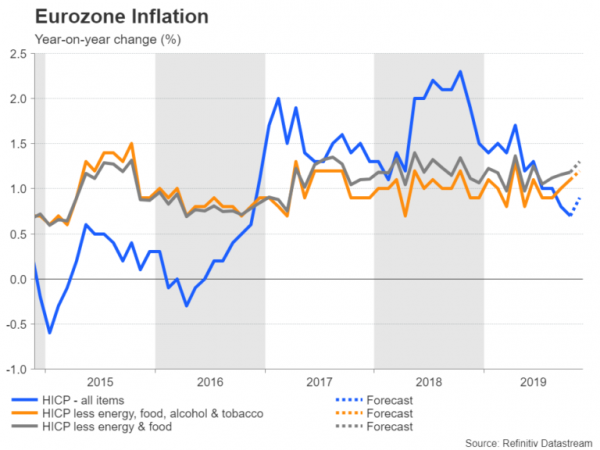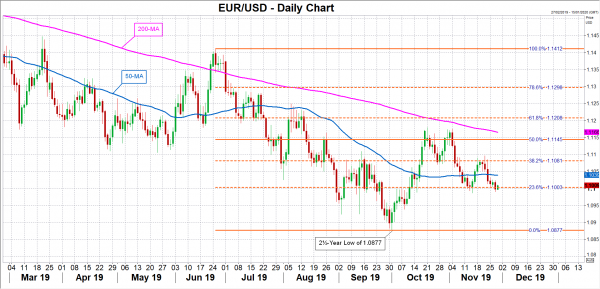The flash estimates of November inflation are due out of the Eurozone on Friday at 10:00 GMT and could point to the first uptick in the headline reading in five months. However, with the European Central Bank not expected to ease again anytime soon, the data isn’t anticipated to cause much of a reaction in the markets, though it may add to the euro’s downside if there is no improvement in the near-term inflation picture.
Eurozone price pressures still elusive
Inflation in the euro area has been on a downward path for the past year as an intensifying trade war and increased Brexit uncertainty have hurt exporters and sapped business confidence, dampening price pressures in the region. The subdued inflation and low growth environment was the main factor that drove the ECB to perform a policy U-turn and announce a fresh round of stimulus in September.
Policymakers will be hoping that inflationary pressures will start to gain traction soon as any further deterioration in the price outlook would put the central bank in a difficult spot given its limited scope for additional easing, not to mention the growing vocal opposition to even looser monetary policy within the Governing Council.
Some pick up expected in November
The headline rate of inflation, or the harmonised index of consumer prices (HICP), is forecast to inch up from a two-year low of 0.7% year-on-year in October to 0.9% in November. If confirmed, this would represent the first increase in the headline rate since June.
Underlying measures of inflation have been steadier, possibly explaining why the ECB hawks haven’t been greatly concerned from the latest fall in HICP. However, neither has there been any signs that the two core measures of inflation are about to trend higher. The annual rate of HICP that excludes food and energy prices is expected to rise from 1.1% to 1.2% in November, while the rate that excludes alcohol and tobacco prices in addition to food and energy is forecast to edge up from 1.1% to 1.2%.
Market response to be muted
If the preliminary inflation numbers are more or less in line with expectations, the market response is likely to be muted. After the full scale of the split within the ECB came to light following the September meeting, very few investors are betting that the deposit rate will be cut further. This implies that the euro has likely reached a bottom and will probably continue to consolidate in the coming months until evidence of a convincing rebound in economic activity starts to emerge.
In the very short-term, however, the euro is susceptible to some selling pressure if Friday’s inflation data disappoints, especially as the US dollar is on the up again lately. Euro/dollar is at the moment being propped up by the 23.6% Fibonacci retracement of the June-October downleg, which lies just above the $1.10 level. Slipping below this key support could push the pair back towards its 2½-year low of $1.0877 plumbed on October 1.
On the other hand, any sign of a positive development on the inflation front could provide the euro with a much-needed lift. Buyers could initially target the 50-day moving average around $1.1040 before aiming for the 38.2% Fibonacci at $1.1081. A successful challenge of this level would open the way for the 50% Fibonacci at $1.1145.
















